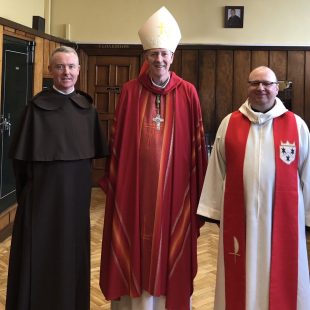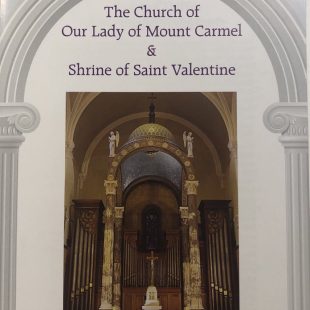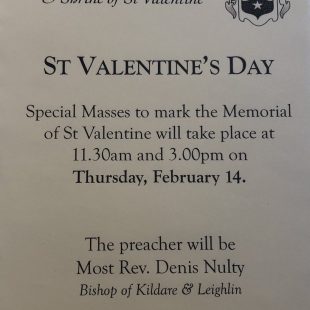Today Bishop Denis celebrates two Masses in Whitefriar Street Church, Dublin to honour the Feast of St Valentine.
Introduction:
It’s a great joy for me to celebrate Mass with you on this the Feast of St. Valentine, honouring a Saint deeply associated with love. Normally I’m over there at the Shrine, as I was two days ago for an annual blessing ritual, organised by ACCORD, of an engaged couple to coincide with todays’ feast. I’m always moved by the reverence and respect shown by you, the daily congregation here in Whitefriar Street, at the Masses that often coincide with that ritual blessing.
The Roman Ritual this morning suggests we celebrate the great Patrons of Europe, the Thessalonican brothers from Greece, Cyril and Methodius, much admired by the late and great St. John Paul II. But here in Whitefriar Street there is a devotion, that goes back 183 years to the time Fr. John Spratt brought from Rome to here the sacred relics of St. Valentine, where they have remained for daily devotion ever since.
Some of you have travelled a distance for this mornings Mass and celebration; all of you are very welcome. In our reflection on the great commandment of love, that St. John so beautifully speaks of, let’s begin our celebration by acknowledging the moments we haven’t loved as we should have and pray for God’s love and mercy …
Homily:
A relic usually consists of the physical remains of a saint or the personal effects of that saint. They offer us a tangible memorial, something we can cling onto, something we can hold, venerate or be blessed with. Immediately, the glove or mitten of St. Pio comes to mind; the mug or chains belonging to Venerable Matt Talbot, or the Crucifix associated with Blessed John Sullivan. Dublin is rich with the relics of the Saints, none more so than that of St. Valentine here in the Church of Our Lady of Mount Carmel, in Whitefriar Street.
I recall the very first relic I ever saw, as a young school boy, was the head of St. Oliver Plunkett, venerated in St. Peter’s Church, Drogheda. Our first reading from St. James speaks of standing firm when our trials came, well no better example than the Oldcastle Saint, Oliver Plunkett who was martyred in Tyburn in 1681. I remember on that first visit to St. Peter’s Church, being as awe-struck by the depth of that door from his cell in Newgate Prison, as I was by the head of the Saint. St. Valentine, a Roman martyr, a third century priest, who ministered to Christians who were forbidden to marry or practice their faith, under the tyrannical rule of Emperor Claudius II. As I said in my words at the Shrine last Tuesday, there is a serious piece of work still to be carried out, deciphering the truth from legend in a saint that goes back so many centuries.
Was St. Valentine an arranger of secret marriages? Did he fall in love with his jailer’s daughter? Did he restore her power of sight? Did he cut out the symbol of the heart in parchment to teach persecuted Christians that God loved them? Did he send a note at the end of his life poorly signed “from your Valentine”? What we do know is he was dragged before the Prefect of Rome who condemned him to be beaten with clubs and beheaded, suffering martyrdom in 269AD, 1,750 years ago this year. So this year is a special year and today is a very special day in the story of St. Valentine.
The story of how St. Valentine’s relics arrived here is well-known. The Irish Carmelite Fr. John Spratt while visiting Rome, was well-known as a skilled preacher. He was invited to preach at the Jesuit Church, the Gesu, who so impressed the glitterati of Rome and the Pope of the day, Pope Gregory XVI that he returned laden down with gifts, including the sacred relics associated with St. Valentine. Amongst those relics was a small vessel tinged with the blood of St. Valentine. All received here in Whitefriar Street Carmelite Church on November 10th, 1836.
What was Dublin like in 1836? Daniel O’Connell, the great liberator was attracting thousands as he spoke on issues such as ‘Justice for Ireland’. After one of the coldest summers in over fifty years, the potato crop failed. September that year saw the first burial at Mount Jerome Cemetery, Harold’s Cross. The ending of the Tithe War, which was a campaign of mainly nonviolent civil disobedience in reaction to the enforcement of tithes on the Roman Catholic majority for the upkeep of the established state church, then, the Church of Ireland. They were different times and St. Valentines relics were carried into the Dublin and Ireland of that time, relics that are associated with love, romance and all things romantic. And the Ireland he was entering was probably anything but romantic at that time, there was poverty, there was injustice, there were the signs of an emerging Irish famine.
St. John following on our reading from St. James reminds us candidly that we must “love one another”[1]. The greatest commandment of all is that we love, we respect, we lay down our lives for one another. So when did this St. Valentine become the catalyst for the commercial interests of sending cards, buying flowers or arranging romantic dinners? The popular custom of showing love and affection on this day is almost a coincidence with this feast day. During the medieval age, a common belief held that birds began to pair on February 14th, it was seen as “half-way through the second month of the year”. Chaucer wrote in his Parliament of Foules in beautiful old English: “for this was on Seynt Valentyne’s day, when every foul; cometh to choose a mate”. For this reason, the day has been dedicated to “lovers” and has prompted a multi-million euro business bonanza that nicely reverses the post-Christmas dip.
So what message do we take home today in 2019? Where is the challenge for us in the 183 years since Valentine’s sacred relics were brought by Fr. John Spratt here to his beloved Carmelite Church? What makes our celebration today that bit extra special in this 1,750th Anniversary of the death of St. Valentine? John Spratt was not only a renowned preacher, he was a social activist of his time, a prominent figure in the Dublin of his day. He was a tireless worker for the homeless and the poor. He founded schools, an orphanage, homes for the blind and a night shelter. Today, 2019, there are far too many still on housing lists, the number of children living in emergency accommodation is a blight on our society. The division between those who have and those who haven’t continues to deepen. Ireland is a different land to the one that welcomed this reliquary in 1836. Very definitely we are in a better place, but like all places we must never become complacent.
I am always interested in the diary that rests on St. Valentines altar. There are entries there from all over the world. People looking for love. People looking for acceptance. People looking for permanence. There are millions of songs, poems, novels, movies about love: losing love, finding love, sharing love, missing a loved one, wishing for love, searching for love, being grateful for love. I could go on.
Pope Francis reminds us “love is a single reality but with different dimensions”[2], ACCORD whom I am privileged to work with, recognises and acknowledges those distinct dimensions. One of our key pastoral challenges is to teach couples about the beauty of Christian marriage and to help them live in harmony together, to overcome their selfishness and to reconcile their differences. The fact that the vast majority of couples who marry in the Church remain faithful to their promises and vows is in itself revolutionary as it shows that couples are not easily subject to the mercy of events or the shifting chemistry of mood. For those who experience challenges in marriage, ACCORD is there to tenderly journey with them.
At the click of a mouse, pornography can be accessed; at the pressing of a button a compromising text can be sent; at the dialling of a premium rate number a date with a stranger can be arranged – but is it love? St. John will remind us: “As the Father has loved me, so I have loved you. Remain in my love”[3]. The heart of Jesus, like the heart of St. Valentine over there is pulsating for all of us. As we hold each other’s hands at the shrine, as we rub the ring on our fingers, as we reflect in silence on what might have been or what is, let us give thanks for the gift of love we all experience this day. One last thought … I always find it intriguing here in Whitefriar Street opposite the Shrine of St. Valentine is that of St. Jude! Perhaps there’s a message in this for all of us. Might it be that love is our neighbour always no matter how hopeless we may feel? May the constancy and commitment of St. Valentine inspire us, and this day may the ring we wear remind us of the commitment we once made. Amen.
[1] Jn. 12:26
[2] Pope Francis: ‘Love in Marriage’, Magnificat Publications, 2017.
[3] Jn. 12:24
ENDS


